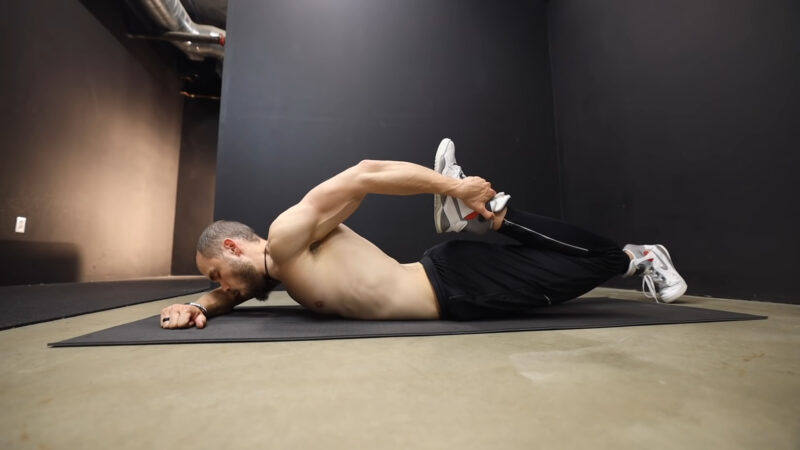A slipped disc, also known as herniated or prolapsed disc, is a condition where the soft, jelly-like center of a spinal disc protrudes through a tear in the tougher exterior. Not only is this discomforting, but it can also lead to immense pain and numbness radiating down the limbs. Thankfully, in most cases, slipped disc pain can be treated without surgery through a combination of lifestyle modifications, physical therapy, and alternative treatment options.
Key Takeaways
- Slipped disc pain can often be treated without surgery through lifestyle modifications, physical therapy, and alternative treatments
- Reducing stress on your spine and strengthening supporting muscles are crucial for managing slipped disc pain and promoting healing
- Acupuncture, chiropractic care, and other alternative treatments can provide additional relief and support in pain management.
- Consistency in treatment and self-care routines significantly enhances the effectiveness of non-surgical interventions.
- Educating oneself about spinal health and adopting preventive measures can minimize the risk.
Pain

Anatomy of the Spine
To understand slip disc pain, it’s essential to know the basic anatomy of the spine. Your spine consists of a column of bones called vertebrae, stacked together. Between each vertebra, there is a cushion-like structure known as an intervertebral disc. These discs act as shock absorbers and allow you to move, bend, and twist with ease.
The intervertebral discs are composed of two parts:
- A soft, gel-like center called the nucleus pulposus
- A tough outer ring called the annulus fibrosus
Overall, the spine can be divided into three main sections:
- Cervical (neck) region
- Thoracic (mid-back) region
- Lumbar (lower back) region
What is a Slip Disc?
A slip disc, also known as a herniated, bulging, or ruptured disc, occurs when the soft nucleus pulposus pushes through a tear in the annulus fibrosus. This can irritate nearby nerves and result in pain, numbness, or weakness in your back, arms, or legs. Slip discs can be caused by factors such as age, wear and tear, or sudden strain on the spine due to improper lifting or sudden movements.
Most slip disc cases occur in the lumbar region of the spine, as this area experiences significant stress and movement. However, slip discs can also occur in the cervical and thoracic regions.
When treating slip disc pain without surgery, a combination of approaches can be effective. This can include exercise, relaxation, pain relief methods, and physical therapy. By understanding the anatomy of the spine, as well as the nature of slip discs, you can take appropriate steps towards managing your pain and promoting a gradual healing process.
Lifestyle Modifications

Posture Adjustment
One of the vital aspects of dealing with a slipped disc is maintaining proper posture. Sitting or standing with the right posture can relieve pressure on your spine and discs, aiding in your recovery process. When sitting, opt for a chair that provides adequate back support and keep your feet flat on the ground.
Additionally, it’s crucial to avoid slouching and to maintain the natural curve of your lower back. When standing, distribute your weight evenly between your feet and keep your knees slightly bent. Practicing yoga and other stretching exercises can further help improve your posture.
Weight Management
Carrying excess body weight can strain your spine and exacerbate a slipped disc. To diminish this additional burden on your spine, it’s vital to maintain a healthy weight. Adopting a balanced diet, rich in fruits, vegetables, lean proteins, and whole grains, can support your weight loss journey.
Regular exercise, including low-impact activities such as swimming, walking, and cycling, is also essential for weight management. Keep in mind that it’s crucial to consult your physician or a physical therapist before engaging in any exercise program to ensure it’s safe and suitable for your condition.
Ergonomic Workspaces
Establishing an ergonomic workspace is another crucial step in preventing and alleviating slipped disc pain. Adjust your workstation to ensure the following:
- Your computer screen is at eye level.
- Your desk and chair heights foster proper posture.
- Your keyboard and mouse are close and within easy reach.
Here’s a brief table to help you set up an ergonomic workspace:
| Item | Adjustment |
|---|---|
| Monitor | Positioned at eye level, approximately an arm’s length away |
| Chair | Adjustable height, with lumbar support |
| Keyboard | At a comfortable height, wrists in a neutral position |
| Mouse | Close to the keyboard, easy to reach |
Ultimately, addressing your posture, managing your weight, and establishing an ergonomic work environment are essential lifestyle modifications to alleviate slipped disc pain without surgery. By staying dedicated to these changes, you can improve your overall spinal health and quality of life.
Physical Therapy Techniques
Strengthening Exercises
An effective way to combat slipped disc pain is through strengthening exercises. Doing these exercises can help enhance the muscles supporting your spine, ultimately lessening the strain on the affected disc. Some examples of these exercises include:
- Pelvic tilts: Lie on your back with your knees bent and feet flat on the floor. Tighten your abdominal muscles and gently press your lower back into the floor. Hold for 5-10 seconds, and repeat 8-10 times.
- Bridges: In the same position as the pelvic tilts, lift your hips towards the ceiling while keeping your feet and shoulders on the ground. Maintain the position for a few seconds before lowering your hips. Perform 8-10 repetitions.
Stretching Routines
Incorporating stretching routines into your physical therapy can not only help alleviate pain but also improve your flexibility. These gentle movements can assist in preventing further herniation:
- Hamstring stretch: While seated, extend one leg straight ahead with your heel on the floor and toes pointing up. Bend your opposite knee and place your foot against your extended thigh. Gently lean forward, reaching towards your toes, and feel the stretch in your hamstring. Hold for 15-30 seconds, and repeat 2-4 times on each leg.
- Knee to chest stretch: Lie on your back with your knees bent and feet flat on the floor. With both hands, pull one knee towards your chest, feeling the stretch in your lower back. Hold this position for 15-30 seconds and then switch to the other leg. Perform this stretch 2-4 times per leg.
Low-Impact Aerobics
Finally, including low-impact aerobics in your therapy program can help enhance overall fitness and contribute to a hastened recovery. Choose activities that don’t put excessive pressure on your back, like:
- Walking: Start with 10-15 minute sessions and gradually increase the duration.
- Swimming: Opt for swim strokes that don’t twist your torso, such as the breaststroke or front crawl.
- Stationary cycling: Use a recumbent or stationary bike on a low-to-moderate resistance level to avoid straining your back.
Remember, it’s essential to consult with a healthcare professional before starting any physical therapy routine. They will guide you in performing the exercises correctly and modify them to suit your needs.
Alternative Treatments

Acupuncture
Acupuncture is a traditional Chinese medicine technique that involves the insertion of thin needles into specific points on your body. It is believed to help balance the body’s energy flow and stimulate healing. For herniated disc pain, acupuncture can assist in providing pain relief and improving mobility. During the treatment, you may experience a slight tingling sensation or warmth, which is normal. Be sure to find a licensed acupuncturist with experience in treating herniated disc pain for the best results.
Chiropractic Care
Chiropractic care focuses on the diagnosis and treatment of musculoskeletal disorders, particularly those involving the spine. A chiropractor may perform spinal adjustments to realign the vertebrae, which can help alleviate pressure on the herniated disc. This non-surgical treatment option can reduce pain and restore your range of motion. Keep in mind that consistency in receiving chiropractic care is essential for maintaining the benefits and promoting healing.
Here are types of chiropractic adjustments that may be beneficial for herniated discs:
- Flexion-distraction technique: A gentle, non-thrusting type of spinal manipulation.
- Pelvic blocking: Utilizes cushioned wedges placed under each side of the pelvis to support a gentle adjustment.
- Instrument-assisted manipulation: A hand-held device is used to apply gentle force without thrusting into the spine.
Massage Therapy
Massage therapy can help alleviate pain and muscle tension associated with a herniated disc. By targeting specific muscle groups, a massage therapist can help improve blood circulation and flexibility in the affected area. Techniques such as deep tissue massage or myofascial release can help to reduce inflammation and improve mobility. It is essential to find a qualified massage therapist with experience in treating herniated disc pain to ensure your safety and receive the most effective treatment possible.
Remember, for best results, combining these alternative treatments with a consistent exercise program and maintaining an anti-inflammatory diet can contribute to an effective non-surgical treatment plan for your herniated disc pain. Consult with your healthcare professional before starting any new treatment to ensure it is appropriate for your specific condition and needs.
Pain Management Strategies

Heat and Cold Therapy
Heat and cold therapy can be effective ways to relieve slipped disc pain without surgery. Heat therapy promotes blood flow, relaxes muscles and reduces pain. You can use a heating pad, warm towel, or take a warm bath. Try applying heat for 15-20 minutes at a time, several times a day.
On the other hand, cold therapy can reduce inflammation and numb the pain. Use a cold pack or a bag of frozen vegetables, and apply it to the painful area for 10-15 minutes, several times a day with at least one-hour breaks in between.
Over-the-Counter Medications
Another way to manage slipped disc pain is using over-the-counter (OTC) medications. Here are some options:
- Anti-inflammatory drugs: Nonsteroidal anti-inflammatory drugs (NSAIDs), such as ibuprofen, can help reduce inflammation and alleviate pain.
- Pain relievers: Acetaminophen may provide relief from mild to moderate pain.
- Muscle relaxants: If you’re experiencing muscle spasms, OTC muscle relaxants can help.
Remember to follow the instructions on the medication label and consult your healthcare provider before using any medication, especially if you have existing medical conditions.
Mind-Body Techniques
Incorporating mind-body techniques into your pain management strategy can be beneficial. Some options include:
- Deep breathing exercises: Focus on slow, deep breaths to promote relaxation and reduce muscle tension.
- Progressive muscle relaxation: Systematically tense and relax different muscle groups to release tension and increase body awareness.
- Guided imagery: Imagine yourself in a peaceful, relaxing place while focusing on your breath. This can help redirect your attention away from the pain.
Explore various techniques to find the ones that work best for you, and practice them regularly to improve your pain management skills.
Frequently Asked Questions
What exercises can I perform at home to alleviate pain from a slipped disc?
To alleviate pain from a slipped disc, you can perform gentle exercises at home like walking, stretching, and low-impact aerobics. For example, you may try hamstring stretches, pelvic tilts, or knee-to-chest stretches. However, it’s important to consult with a physical therapist or healthcare professional for personalized recommendations based on your specific condition.
Which over-the-counter pain medications are most effective for a herniated disc?
Over-the-counter pain medications such as nonsteroidal anti-inflammatory drugs (NSAIDs) like ibuprofen or naproxen can help relieve pain and inflammation related to a herniated disc. If NSAIDs are not effective, you can consider taking over-the-counter analgesics like acetaminophen. Before taking any medication, consult with a healthcare professional to determine the most suitable option for you.
What are the indications that a herniated disc is healing?
Signs that your herniated disc is healing may include a decrease in pain levels, improved mobility, and less numbness or tingling in the affected area. Keep in mind that healing times vary, and it’s important to be patient and continue with your prescribed treatment plan even if progress seems slow.
What non-surgical treatments can help with l4 l5 disc bulge discomfort?
Non-surgical treatments for l4 l5 disc bulge discomfort include physical therapy, medications, and lifestyle changes. Physical therapy exercises may include core strengthening, stretching, and low-impact aerobics. Medications such as NSAIDs can help with pain management. Maintaining a healthy lifestyle, including a balanced diet and regular exercise, can also contribute to alleviating discomfort.
Are there any home remedies that can expedite the healing process of a herniated disc?
There are no specific home remedies to expedite the healing of a herniated disc, but adopting certain practices can help support recovery. These practices include maintaining good posture, applying ice or heat packs to the affected area for pain relief, and engaging in gentle exercise or stretching routines as recommended by your healthcare provider.
Can sciatica and herniated disc pain be managed effectively without surgery?
Yes, sciatica and herniated disc pain can often be managed effectively without surgery. Non-surgical treatments such as physical therapy, medications, and lifestyle modifications typically provide relief for most patients. Surgery is usually considered as a last resort if conservative treatment options fail to alleviate symptoms and improve your quality of life.
